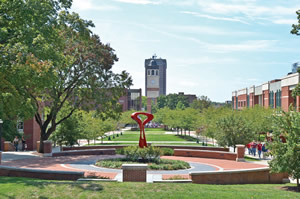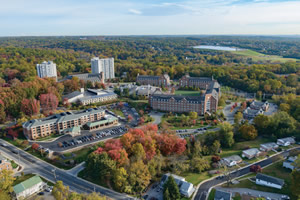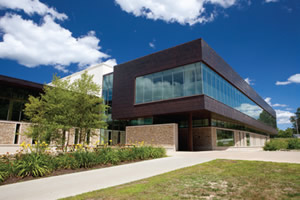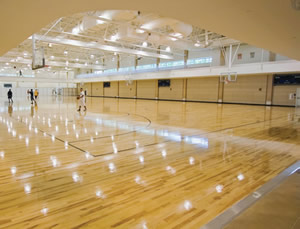Getting Creative With Facilities Financing

PHOTO COURTESY OF BBADGETT
According to Sally Grans Korsh, FAIA, LEED-AP, director of Facilities Management & Environmental Policy for Washington-based National Association of College and University Business Officers (NACUBO), there are two reasons why campus administrators are seeking alternative financing methods for their facilities. “The first reason,” she indicates, “is that 80 percent of all campus costs are involved with staff salaries, which doesn’t leave a lot of wiggle room for new debt or operational costs.”
The second reason involves the facilities themselves. Many facilities are 50 or more years old and have maintenance challenges that eat up operational costs. Plus, program shifts are requiring facility design changes. For example, classroom collaboration and cross-disciplinary discussions mean that classrooms lined with rows of student chairs and a desk for the instructor at the front no longer support teaching and learning needs.
So, how are administrators to come up with much-needed facilities funding? By getting creative. Here are some examples.
Establish a Foundation to Pay for Renovation and New Construction
In 1997, administrators at Western Kentucky University (WKU) in Bowling Green found themselves needing to heed a new state mandate to install fire suppression systems in their residence halls. In addition, they had a number of residence halls that needed updating. “The state had a biennial budget, and they didn’t always approve agency bonds,” says Brian Kuster, vice president of Student Affairs and executive director of WKU’s Student Life Foundation (SLF). “So we wondered how we could make improvements without asking for state bonding, especially because we knew we would not get as much money as we needed.”
The administrators created a task force comprised of employees, alumni and local CEOs to brainstorm, and they landed on the idea of a 501(c)(3), which they called SLF. “In this scenario,” says Kuster, “the university would sell its housing assets to the foundation, and the foundation would sell bonds to get funding, with the university maintaining management of the residence halls. In 2000, SLF sold $65 million in bonds, of which it paid $20 million to WKU for its 15 residence halls.”
Since the foundation was established in 1999, $150 million has been invested in WKU’s housing facilities. In its first 10 years, every bed on campus was renovated, and a central chiller plant, which sells chilled water to the university, was constructed to cool the residence halls.
“SLF is generating about $25 million in revenues yearly,” says Kuster, “plus an additional $4 million in surplus that goes back to renovation and new construction. In February we refinanced our outstanding bonds and borrowed $28 million to build a facility that’s under construction now. So we have an outstanding debt of about $110 million and, even with that, we’re generating excess revenues.”
A newly completed 10-year master plan includes a $100-million investment in new construction or renovation of existing buildings. “Because of SLF,” Kuster notes, “we’re well above the curve in both the condition and long-term health of our residence halls, which include 5,200 beds that are 100-percent occupied.”
Set Up a Revolving Fund to Finance Energy Efficiency Improvements

PHOTO COURTESY OF THE UNIVERSITY OF DELAWARE
Founded in 2005, Sustainable Endowments Institute (SEI) has pioneered research, education and outreach to advance resilient institutional responses to the climate crisis. One of the organization’s initiatives is the Billion Dollar Green Challenge. Launched in 2011, The Challenge, as it is called, “encourages colleges, universities and other nonprofit institutions to invest a combined total of one billion dollars in self‐managed green revolving funds that finance energy efficiency improvements,” according to its website (greenbillion.org).
“So far, 65 institutions with $135 million in capital are participating in the program,” says Mark Orlowski, SEI’s founder and executive director. “Every organization runs its own revolving fund. It serves to break you out of the normal budget cycle of fighting for money for projects, and treats projects as investments to repay the initial loan from savings.”
With a revolving fund, you use the same capital again and again. It’s compelling to tell a donor that his gift keeps on giving. “It’s also much easier to secure capital from different sources,” says Orlowski. “For example, University of Vermont has $13 million, which it lends to its cash reserves, and which, when launched three years ago, represented 10 percent of all its cash holdings.
One benefit of joining The Challenge is use of Green Revolving Investment Tracking System (GRITS), a customizable web-based project management tool for planning, tracking and organizing projects. “GRITS makes it really simple to enter a project,” says Orlowski. “Once you enter basic data, it will tell you ROI, payback period and internal rate of return, all integrated and easy to use. You can train to use it in one hour.”
Run a For-Profit Within a Nonprofit, AKA ‘Build a Hotel’
Imagine partnering with a business group to construct a hotel on your campus and, in the business deal, you put up 75 percent of the funding, or $9 million, to build the hotel, but you also get 75 percent of the proceeds. According to a 2006 University Business article titled “101 Smart Revenue Generators (and Money-saving Ideas),” this is exactly what administrators at University of Delaware (UD) in Newark, did.

PHOTO COURTESY OF THE UNIVERSITY OF MAINE
“The university has a very fine hospitality management program,” explains William Sullivan, managing director of Marriott Newark and faculty member in UD’s Hospitality Business Management Department. “For years there was discussion about having a hotel that could be used as a teaching hotel and provide lodging to parents, university guests and the local business community. The decision was made in 2001, and the facility opened in November 2004.”
As an independent venture, the hotel was not funded by university tuition and is a for-profit business owned by UD. “It was a requirement that we be self-sustaining,” says Sullivan, “as an early concern was that we not be a financial liability to the university. That model has worked very well. Specifically, we generate more than $5 million each year, funding improvements through that income. Also, partnering with a successful company like Marriott, as opposed to doing it ourselves, was a good decision.”
On the teaching side, 45 to 50 students per semester train at the hotel. “Our students get a whole semester of direct engagement with our guests and operating the facility,” says Sullivan. “This experiential learning is a valuable asset for their resumes when they begin their job search.”
Invite the Community to Campus
As an auxiliary service, New Balance Student Recreation Center at the University of Maine in Orono draws students to the university, offering them a place to exercise and socialize outside of classes. The facility is in year 10 of a 25-year bond that has a $1.3 million yearly debt service.

PHOTO COURTESY OF THE UNIVERSITY OF MAINE
Money comes in via student fees, which amounted to $2 million last year, and generated revenue, which was a little more than $3.5 million last year. In addition to the debt service, the facility’s expenses include heat, lighting, water, sewage, maintenance, technology and salaries. To give you an idea of the fees, last year it cost $243,000 to heat the building.
“Fortunately,” says Jeff Hunt, director of Campus Recreation, “last year we were $600,000 in the black, which we put into a capital reserve account for the building.”
These are big numbers, and the thought of not having enough income to cover expenses can be daunting. But not for Hunt, who looks beyond traditional means of income such as programming, facility rental and vending sales by empowering his employees to come up with non-traditional means. This has led him to off-campus funding sources. “For example,” he says, “because we’re rural and have a healthcare center in town, we have a corporate membership for its employees,” he says.
Also, Hunt partners with town leaders to provide recreational services. “For example,” he says, “our summer camp is in conjunction with Orono Community and Parks Department, which has no facilities. We’re looking to expand this program to ensure services are available even as the town’s resources shrink.”
While finding creative funding sources to manage debt and provide excellent facilities is important, it’s just one part of a three-pronged platform that includes finance, facilities and academics. “When all three of these elements are in balance, fitting together within the overall master plan and vision of the institution,” says Grans Korsh, “then you can be sure you’re moving in the right direction.”
This article originally appeared in the issue of .